Balance and falls prevention – Don’t be the fall guy!
Mon,Jun 24, 2019 at 04:00PM by Carla Mullins
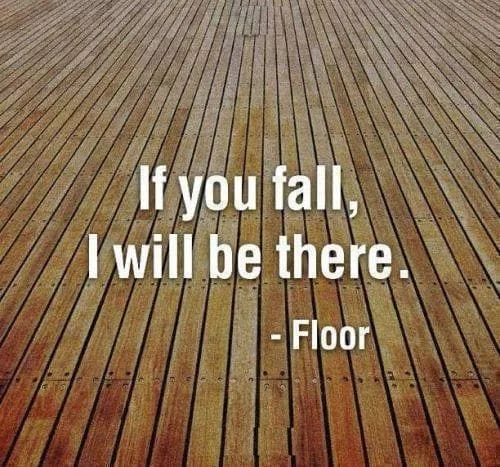
“I had a fall” is something that no one wants to hear their older parents or clients say.
Balance and falls
Falls are sometimes thought of as ‘just one of those things’ that are part and parcel of getting older, with balance and falls issues being all too common. There is no dispute that balance is something that deteriorates as we age. Studies at the University of Queensland have shown that this deterioration starts as early as our forties, which is surprising. This research highlighted that women, in particular, lose balance much earlier than men, with the reasons why this happens is unknown. However, what is known is that we can train the balance systems so as to minimise the risk of falls, along with their potentially serious consequences. If you are interested in the issues covered in this blog, you can find out more in our online course called chucking a wobbly.
One of our clients is a lovely man in his late eighties who started Pilates with us five years ago. Before starting Pilates he would average five to six falls a year, at times leading to hospitalisation and other complications. Through working on improving balance, strength and movement in Pilates classes, there has been a reduction in this gentleman’s fall frequency to just one fall last year. This is despite the development of some serious systemic conditions and chemotherapy.
Falls are a significant concern for all of us, but even more so if you have conditions which mean a fall can result in broken bones; e.g. if you have osteoporosis. In Australia the exercise guidelines for people with osteoporosis place a big emphasis on falls prevention through balance training.
In this article we will explore:
// Some of the concepts that underpin our balance systems
// Ideas and exercises that can be incorporated into our regular Pilates practice, both in the studio and as part of homework
// Some safety precautions
More detailed information about conditions, precautions and strategies for conditions like Benign Proximal Vertigo are addressed in the ‘Chucking a Wobbly’ course which Body Organics will be delivering in 2020. If you are a client experiencing dizziness or vertigo you should discuss this with your Pilates teacher, who will ensure that you are referred to the right physiotherapist or doctor to investigate the symptoms and causes.
Balance senses and systems include:
The balance system in our body incorporates three major senses, namely:
// Visual – what we are seeing
// Proprioception – where we are in space and how to maintain posture in relation to gravity
// Vestibular – how our head is sitting in space and our head righting response in relation to gravity
All of these senses feed back to part of our brain called the cerebellum. To learn more about it you can try our online Introduction to Neuroanatomy course, which explains many of the neurological terms and concepts that you will read in this article. The cerebellum is situated at the back of our head and is essentially the coordination or headquarters for all of the sensory information about where we are in space, and what we are seeing. The cerebellum coordinates our motor responses that stop us from falling. Remember, there are three major systems of the body when it comes to the balance systems:
// Sensory systems – visual, proprioception, vestibular
// Processing systems – cerebellum and other major nerve control systems
// Skeletal & muscular systems – which are needed to respond and move. Your eyes have muscles as well, so even they need to be trained just as much as the muscles of the legs etc.
All three of these systems need to be considered and focused on when you are working with clients – just lifting weights is not enough. An understanding of the cognitive processes that are called upon in Pilates and Gyrotonic classes is essential to appreciate why these classes are so effective in helping with balance outcomes.
The visual system, what is it?
The visual system is constantly adjusting to make sure:
// Our eyes don’t blur when we move our head. The eyes can stay fixed on a spot and focused when we move the head, which is important when we are doing multiple things. This ability is attributable to the vestibular ocular reflex (VOR).
Try this little test to understand the VOR:
– write your name on a piece of paper
– look at the piece of paper and move it rapidly whilst keeping your head still and eyes fixed on your name
– now keep the paper still and keep your eyes fixed on your name whilst you turn your head from side to side
// The eyes see things in space so we don’t trip over them. This can become a bit of a problem for people with glasses or cataracts, as their peripheral vision can become affected, potentially resulting in trips or bruises on their sides. I have to admit I have a very high level of myopia and am constantly tripping on things. This loss of vision in our peripheries can become an issue as we get older, as cataracts are quite common. Remember also that cataracts are a common side effect of medications such as glucocorticoids – often used to treat inflammatory conditions like asthma (in Australia 12% of the population has Asthma), or Rheumatoid Arthritis (in Australia about 2-3% of the population have this condition).
If you don’t have poor vision, try putting your hands up to the sides of your eyes, as if you have horse blinkers on. Now just walk around and note how clumsy you have become.
Some ideas that can be incorporated into a Pilates class include:
// Closing the eyes when doing some standing or walking exercises.
// Having the person do pivot work whilst they are looking into a dark corner, and have them pivot to a light part of the room. The idea being to train people to have faster adjustment of their eyes. Remember many falls occur at dawn and dusk or when a person moves from a dark room to a light room.
// Not using terms like fix your eyes on a spot, to help you balance. I know I hear this term often from yoga teachers and while this cue is great for a temporary balance it can create over reliance on the visual system for balance, which can then lead to problems when we can’t rely on our eyes, e.g. when we are needing to adjust our eyes. The lesson from this is to constantly keep the movement cues varied and appropriate so that you are not creating new compensatory patterns.
// Some ideas would be to incorporate eye disassociation exercises into your class, e.g. the head series on the CoreAlign or Jump Stretch Board. There are some great ideas that are used in the Feldenkrais method as part of the sensory awareness training for the eyes.
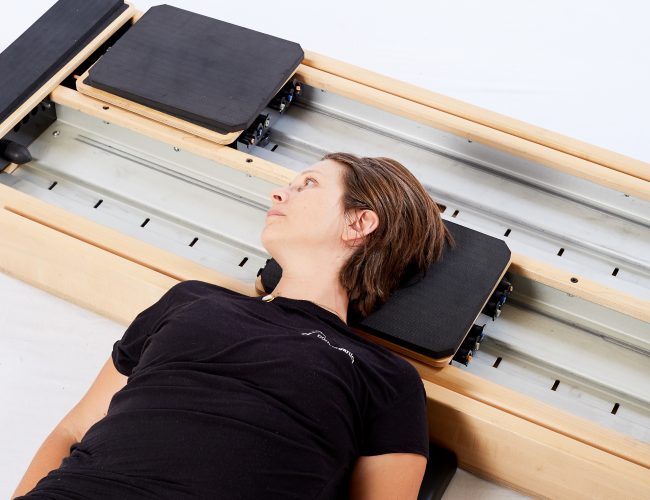
This head turn series using the CoreAlign is from our CoreAlign Manual 4. The exercise is nicely adapted to the Gyrotonic Jump Stretch board work.
The proprioceptive system, what is it?
The proprioceptive system is essentially the sensory information in our joints that feedback to the muscles telling us where we are in space. This is where Pilates and Gyrotonic teachers come into their own when working with clients. Our focus is about alignment and teaching a person about their relationship with space and gravity.
In a good movement class your teacher is constantly asking you “how does that feel?” I know I will make clients walk around after certain exercises or activities in order to refocus their awareness to what is happening and what they are feeling. This is part of the process of teaching and integrating movement and the proprioceptive system into better overall balance systems. It is one of the reasons that all of the Pilates teachers who work for Body Organics or who are trained by us are encouraged to work in small semi-private arrangements with our clients. This process allows us to help clients change their behaviour and create a new relationship with their body. Pilates and Gyrotonic are not simply exercises, they are movement systems aimed at improving the quality of life and experience of a client, not just about looking good for summer!
When working with people on the equipment I like to ensure that at first there is a closed loop system – i.e. the joints are pressing into a bar or a wall. This is what allows the joints to get feedback about where they are in space. The chain can be slowly opened to help build awareness and control when they are moving around in the world.
Experiential anatomy
Open chain – If you are not sure what I mean, put your arm out to the side, feel where it is, and think about what is happening in your shoulder
Closed chain – Now put your arm out and press the hand out into the desk or a wall. Can you sense your shoulder organisation a little bit more? Is it easier to feel how the arm and shoulder are linked?
When you look around a good movement studio you will notice that the equipment has capacity to perform closed chain activities. The teacher will generally start you with the joint organisation so that the muscle recruitment and the messages back to the cerebellum about the proprioceptive system can be clear. It is then easier for a client to build an understanding of their bodies orientation and how to organise themselves.
Vestibular system, what is it?

Middle ear
The vestibular system, which is partially embedded in our middle ear, is the snail like image above. The rest of the system is linked to nerves and processing sites in our brain, however let’s start with the middle ear components, which include:
// The semi-circular canals – one set in each ear with different orientations to detect a variety of movements such as nodding or rotating. Movement of fluid inside the canals caused by head movement stimulates tiny hairs that send messages via the vestibular nerve to the cerebellum.
// Two otolith organs (called the saccule and utricle) send messages to the brain about body movement in a straight line (backwards/forwards or upwards/downwards) and also about where the head is in relation to gravity (such as tilting, leaning or lying down). These organs contain small crystals that are displaced during these movements to stimulate tiny hairs, which transmit the message via the vestibular nerve to the cerebellum.
So, what do all of these vestibular concepts mean when I am moving?
Essentially when you move your head, either the hairs in your ears or the crystals will help you adjust your posture so that you do not fall down! If you get dizzy or nauseous when you move your head, this will give you an idea that some of these systems are not working optimally. This is what the doctor or the physiotherapist/osteopath/chiropractor is testing when they ask you to move your head in certain directions.
For example:
// Move your head as if saying yes or no. In those movements you are moving the fluid in your head and triggering the little hairs, so you can imagine that when you are in a movement class exercises like chest lift and chest pull on the reformer could trigger a vestibular response (sometimes not always good)
// Moving your head in the spirals as on the Gyrotonic apparatus – this can trigger some of the otolithic crystals
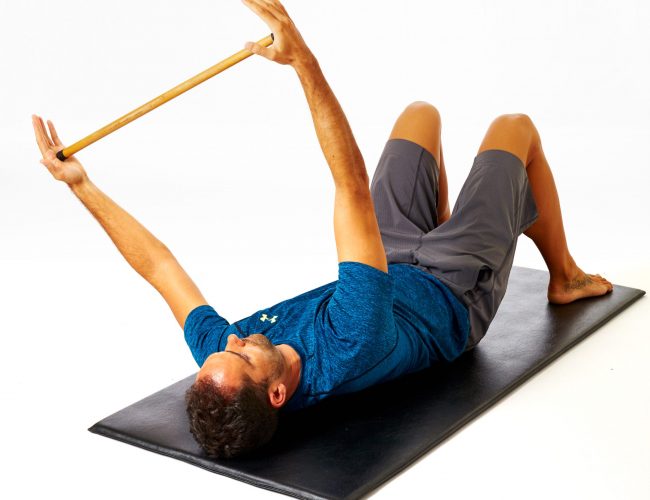
Moving the stick or moving the head as you lie on the floor
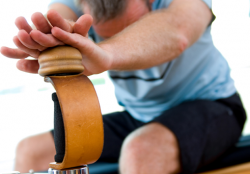
The stirring exercises using the gyrotonic tower
 Balance and vestibular ideas
Balance and vestibular ideas
Progressions of exercises are quite possible when you are working with a well trained movement teacher. It is important to remember that when training in these disciplines the teacher undertakes thousands of hours training and observing people in dynamic activities. A well trained movement teacher is able to quickly modify and tweak your activities to provide the sorts of functional balance work needed to keep a person engaged and challenged – week in, week out.
I enjoy using many of the traditional Pilates equipment to help with balance, as well as CoreAlign, Gyrotonic and Makarlu Lotus, all of which add dimensions and variety to clients programs.
Some of my favourite ways to build on balance challenges and engagement in the studio are:
Example 1: Reformer work
// 4 point kneeling on the floor, or wall elephant
// Knee stretch on the reformer +/- eyes fixed, eyes moving from side to side from hand to hand, moving the head (VOR stimulation)
// Twist knee stretch on the reformer (challenging the otolithic organs in the vestibular system)
// Down stretch on the reformer with the eyes moving up and down (in the same or opposite directions to the body as the body swings back and forward on the reformer)
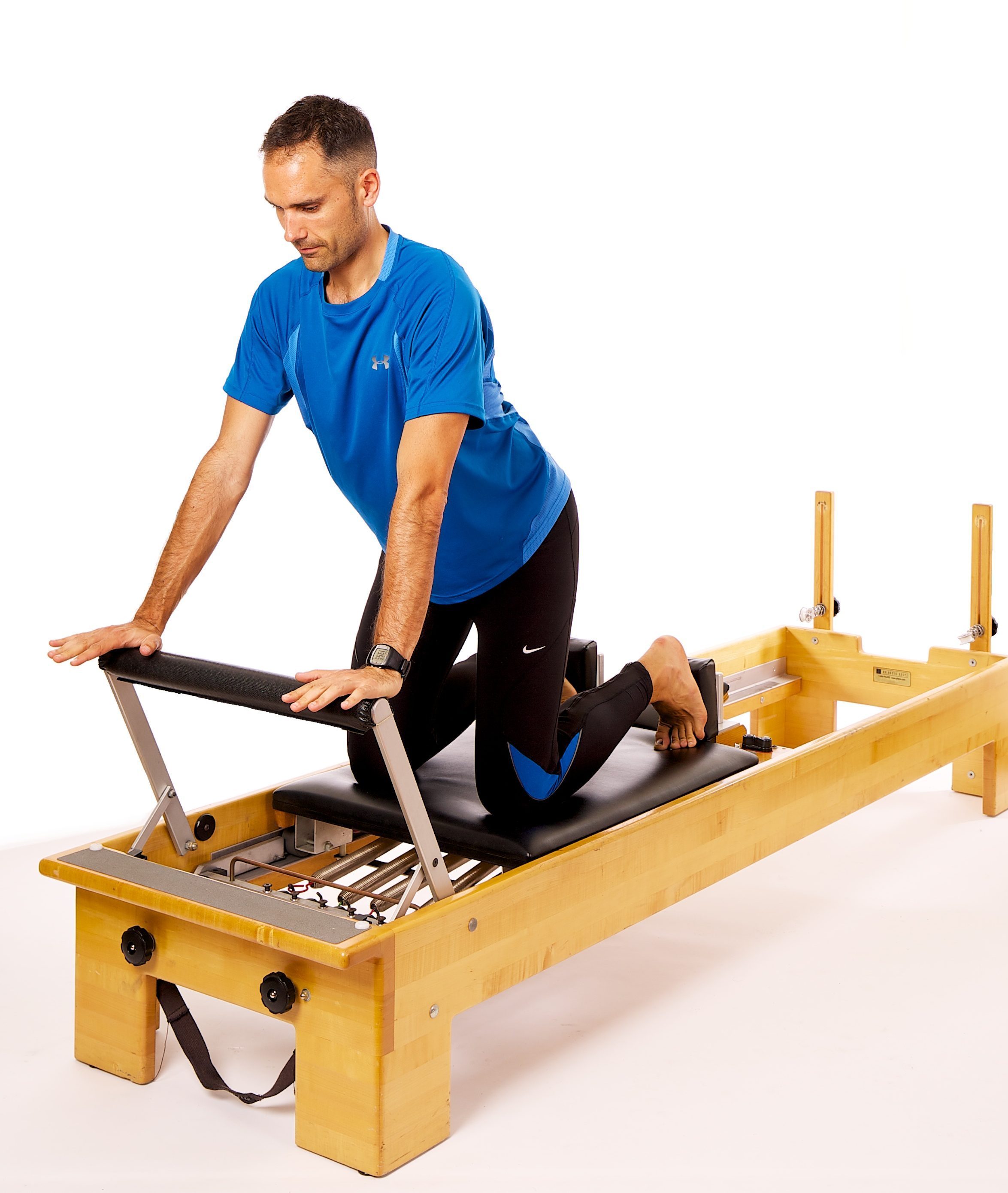
A traditional knee stretch using the pilates reformer- progression to moving eyes or moving head
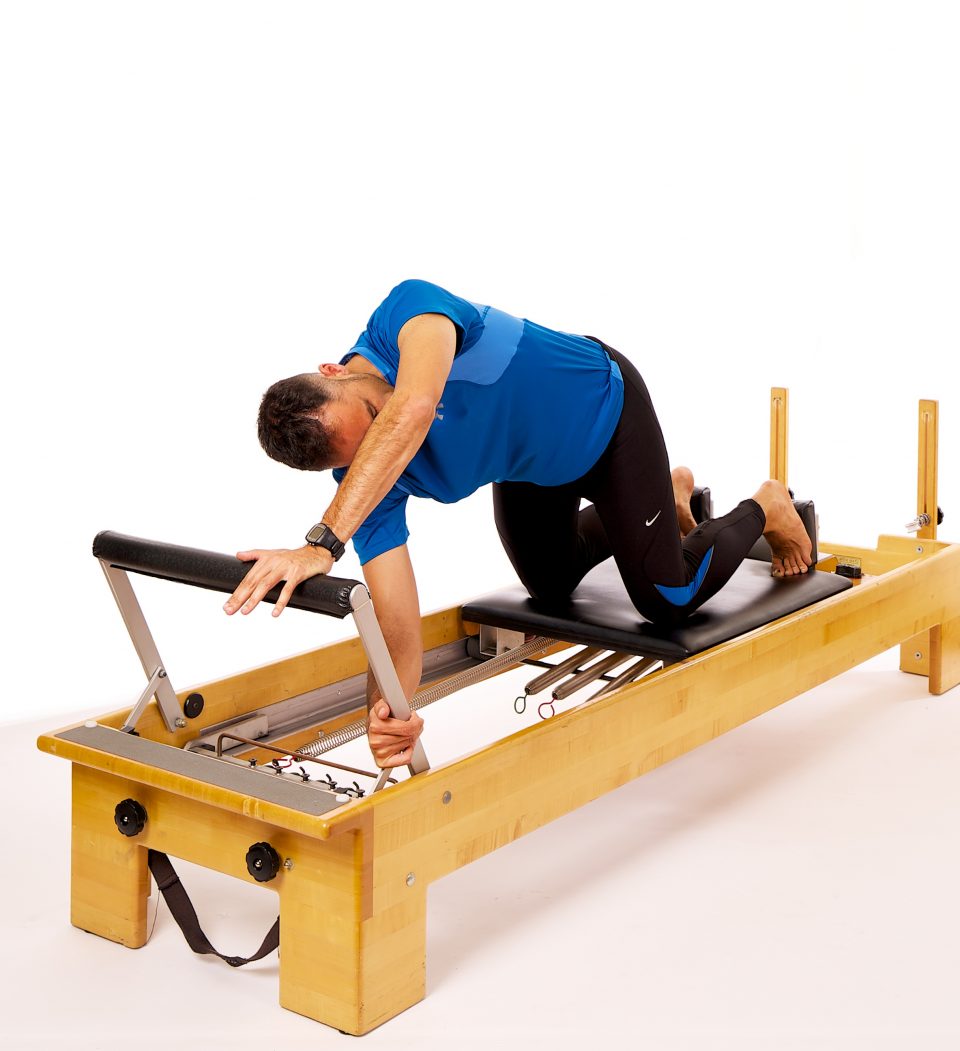
This progression can be done with or without springs. The turning of the head is part of the challenge to the vestibular system.
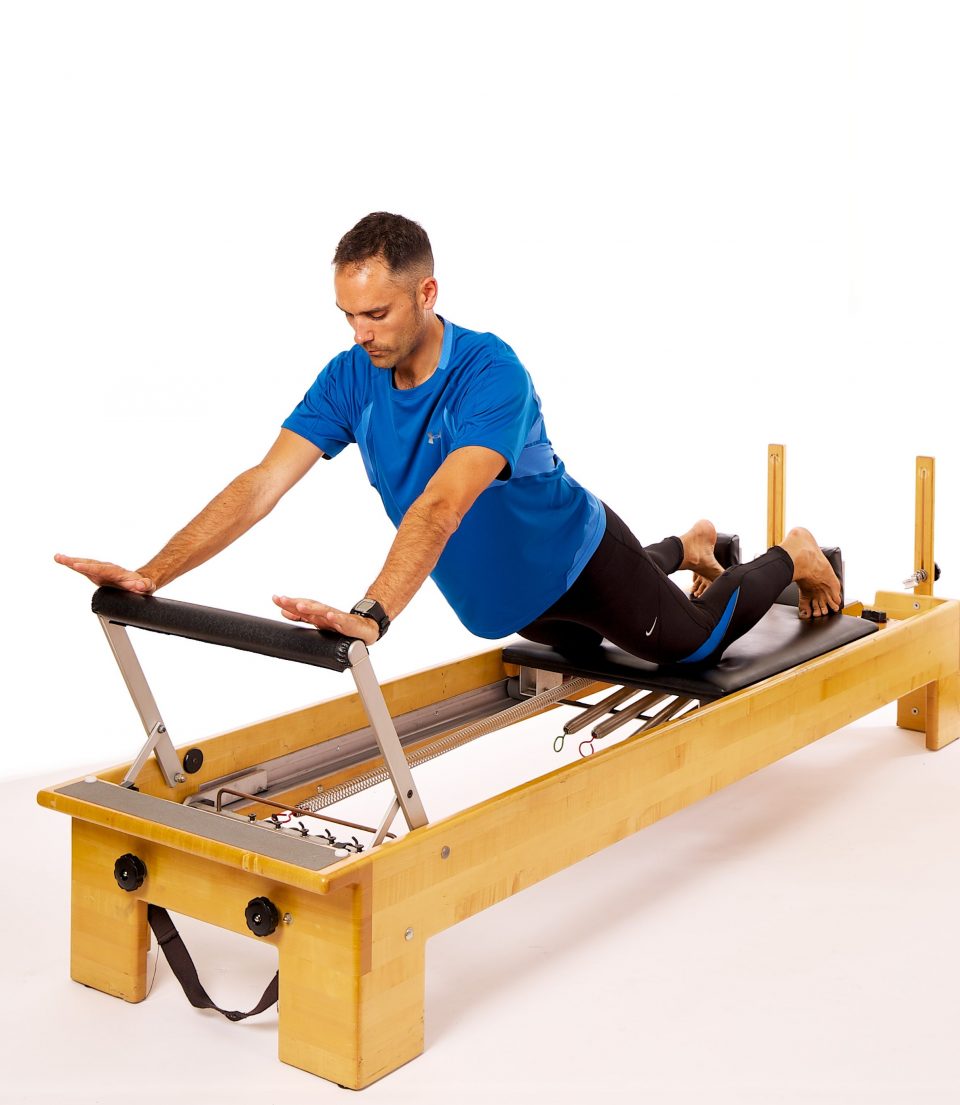
Down stretch progression would include moving eyes up and down.
Example 2: Walking on the balance beam
// Walking back and forward on the timber floor. To challenge, add a softer surface for the person to walk along, such as a mat or balance beam
// Walking along the beam. To challenge, add nodding the head up and down or turning the head from left to right (challenging the vestibular semicircular canals), or move the head from side to side so that the ear goes to the shoulder (challenging the otolithic organs in the vestibular system)
// Walk along the floor in a straight line with eyes closed
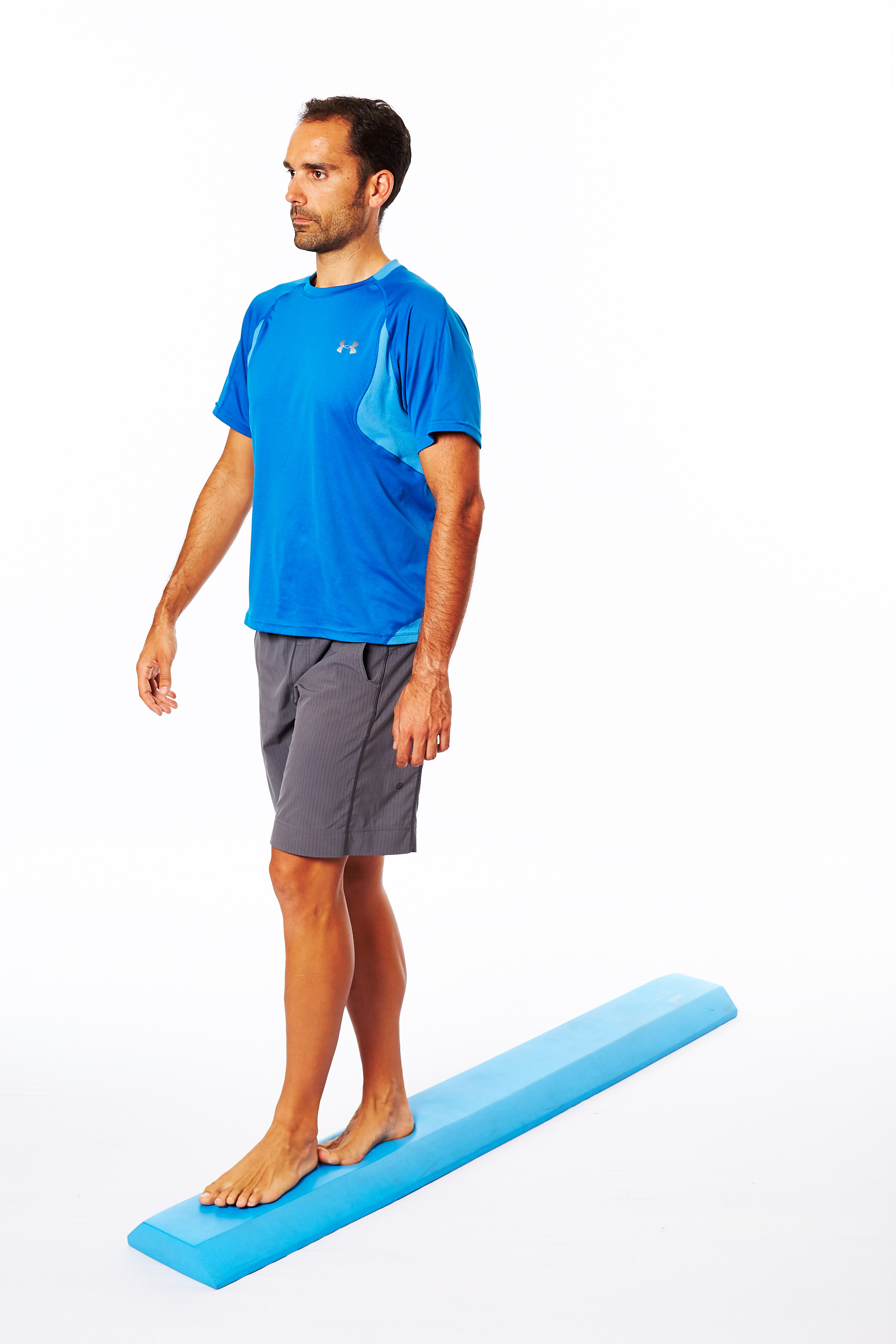
Walk in a straight line on a soft surface (if too hard, start the person on the floor with a hard surface to walk on)
Safety precautions for balance and falls
It is important to remember that dizziness and vestibular conditions can be a consequence of significant medical problems e.g. multiple sclerosis, stroke or Parkinson’s Disease. I recall a time with a particular client when I had noticed a deterioration in her gait pattern over the course of a month or so. She also seemed to be constantly dizzy, so I insisted that she go to a doctor. I told her that I would not allow her at the studio until she had done so, so she started going to a different practice. Two months later she rang to let me know that I had been correct in my concern. She had been experiencing a brain bleed and was having surgery to have a shunt placed in her brain. She had not wanted to go to the doctor because of a family history of Parkinson’s disease which meant that she was understandably concerned and did not want to confront the issue. It seemed that her existing Pilates teachers had observed changes in her that the new practice had not detected or thought to act on. The moral of the story is, if you observe unusual gait or movement changes in a client, find ways to help them follow up and check on these issues.
Some tips for teachers:
// Remember that conditions like drop foot can increase a person’s risk of falling, so it’s good to incorporate exercises for feet into your movement class. Some ideas for working with drop foot can be found in this article.
// Balance practice should be done near a wall or a place in which a person has support structures to grab onto for safety if needed
// Make sure steps and trip hazards are clearly marked or minimised
// Don’t place someone into an unsafe position like standing on a reformer, bosu, or balancing with heavy weights, unless there is appropriate support in place and it is suitable for the person’s ability
// Know the signs of stroke
// Make sure you have clients follow up with their doctor if they are having repeated concerns about vestibular or balance issues
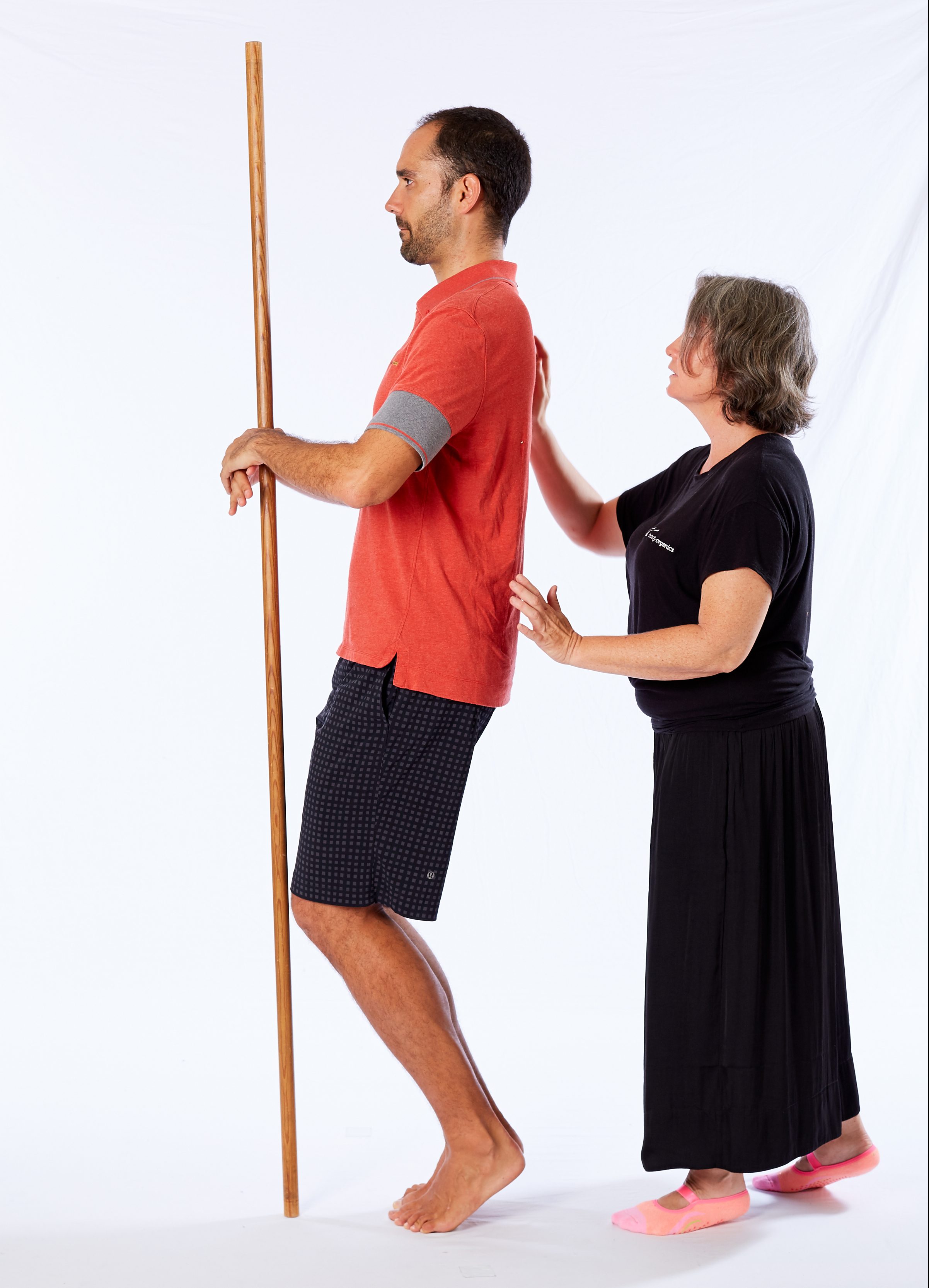
Carla making sure Manuel is not going to fall when he is doing balance exercises
Remember when working with clients it is more than just “muscular strength” that we are working with, it is also about neural responsiveness. Furthermore, it is important for your clients to know that your focus is ultimately their overall quality of life. This quality of life comes from good movement patterns and their ability to continue to engage in the world around them. If you can work together as a team in which your client owns responsibility for their health, then you are part of the way towards achieving a great outcome.
In preparing this article I would like to say a special thank you for the specialist training courses about Central Vestibular Disorders as provided by Dr Carlo Rinaudo from the Brain Hub. His generous and passionate knowledge and understanding of this topic is inspiring, and has encouraged us to work further in improving the balance of our clients, and knowledge of movement practitioners around this important topic.
If you would like to learn more about balance you can participate in our online course called Chucking a Wobbly.
 0
0 